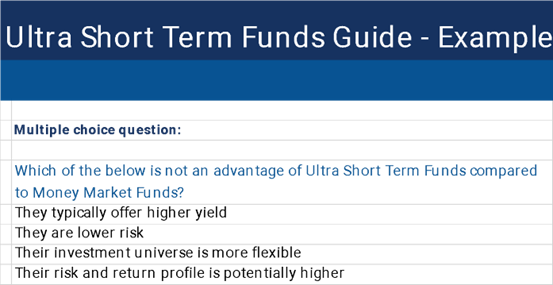Ultra-Short-Term Funds Guide
July 1, 2022
What is an “Ultra Short Term Fund”?
Ultra short-term funds, also known as ultra-short duration or ultra-short bond funds, are collective investment schemes that invest in fixed income securities with very short maturities. Because of the specific focus of these funds, they seek to invest in bond issues with durations of less than a year and therefore have very limited interest rate sensitivity. As a consequence, the return profile of these funds is expected to be relatively modest compared to bond funds with longer durations as shorter duration funds bear lower risk. The investment universe includes both investment grade government and corporate bonds, but may also extend to some high yield issues.
Key Learning Points
- Ultra short-term funds are mutual funds that invest in fixed income securities with a very short duration.
- The underlying holdings of these funds typically have maturities of less than one year and can include instruments like government or corporate bonds, mortgage-backed securities, and other debt-based securities.
- In terms of risk, ultra-short-term bond funds rank above money market funds since they can invest in a wider range of instruments.
- A key feature of these funds is that they exhibit low sensitivity to interest rates and therefore bear less risk compared to longer-duration funds.
How Ultra Short-Term Funds Work?
Ultra short-term bond funds are often seen as a refuge in a rising interest rate environment since they invest only in securities that mature in a short period. Therefore, they are viewed as a more efficient instrument compared to funds with longer duration during periods of high inflation due to their lower interest rate sensitivity (i.e. high inflation would force central banks to increase interest rates, which in turn would make new issues more attractive to investors since they offer higher yield).
Credit Quality
Due to their investment philosophy, ultra short-term funds have limited exposure to credit risk. While issuers can still face financial difficulties or downgrades, the holding period is significantly shorter compared to medium and long-duration portfolios (duration is one of the primary risk measures of fixed income securities), thus limiting the risk exposure.
When it comes to credit quality, these funds have the flexibility to invest in both higher and lower quality issues, for example, the lower end of the investment-grade or the higher end of high yield. Generally, investors should bear in mind that the lower credit quality may broaden the return opportunity, but also introduces greater risk.
Are Ultra Short Term Funds Safe?
While ultra-short duration funds do not guarantee capital safety or assure returns, they are a sensible solution for conservative investors who seek to remain invested for a period of three months to a year. Short-term volatility, for example, daily or weekly, is still a consideration but the risk of capital loss typically declines after three or more months of the initial trade date.
Ultra Short Term Fund vs Liquidity Funds
Liquidity funds (money market funds) are another popular tool for risk-averse investors who seek to park their cash temporarily. They are open-ended in structure and invest in high-quality fixed-income securities such as certificates of deposit, treasury bills, and commercial paper. However, one notable difference from ultra-short-term funds is the target maturity – no more than three months (or 91 days). As their name suggests, they are highly liquid in nature and there are no lockup periods, meaning investors have unrestricted access to their funds.
Due to the marginally higher risk, ultra short-term funds are expected to deliver slightly higher returns than liquidity funds. On the risk spectrum, they sit above liquidity funds and below short-term funds, therefore the risk is still quite low. The opportunity comes with the longer holding period and the fact that liquidity funds usually hold their securities until they mature (hence there is no trading).
How to Use Ultra Short-Term Funds in a Portfolio
While the risks associated with ultra-short-term bond funds are relatively low compared to products with medium and long durations, and nowhere near other asset classes such as equities, they are more suitable as a satellite holding to complement a diversified portfolio. As a lower-risk investment, these products often appeal to more conservative investors who would like a higher yield than that offered by money market instruments and cash savings accounts.
Ultra-Short Bond Funds and High-Interest Rates
With the end of the low-interest rate era, investors are increasingly assessing the potential impact of high-interest rates on their bond allocation. The transition has been extremely challenging for long-duration issues, which tend to be hit the hardest in such an environment. The potential for more short-term rate increases leaves bond investors facing capital losses as yields rise. While the opportunity to earn better yields in the future could be good news, ultra short-term funds may be an attractive option since following a rate rise, their yields are likely to outperform those offered by bank savings accounts and liquidity funds. That could also potentially ease the pain of the initial losses suffered when rates first rose. In addition, as yields increase significantly, a higher starting yield can potentially cushion against further capital loss if rates rise more than the market currently anticipates.
Examples of Ultra-Short Bond Funds
Although these funds may sound appealing to a niche market, they are quite popular with institutional investors and have recently begun to gain traction in the retail market. The range of products available to both types of investors has expanded in recent years. One thing that investors should bear in mind when selecting ultra short-term funds is management fees. Since the return opportunity is quite limited, higher expense ratios can erode real returns. Some popular providers of ultra-short-term funds include iShares (a subsidiary of BlackRock), SPDR, and Vanguard.
To learn more about ultra short bonds, enroll in our portfolio management course.

Download the Excel files for the answer.